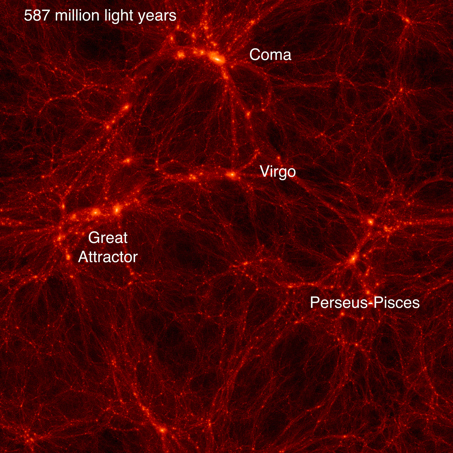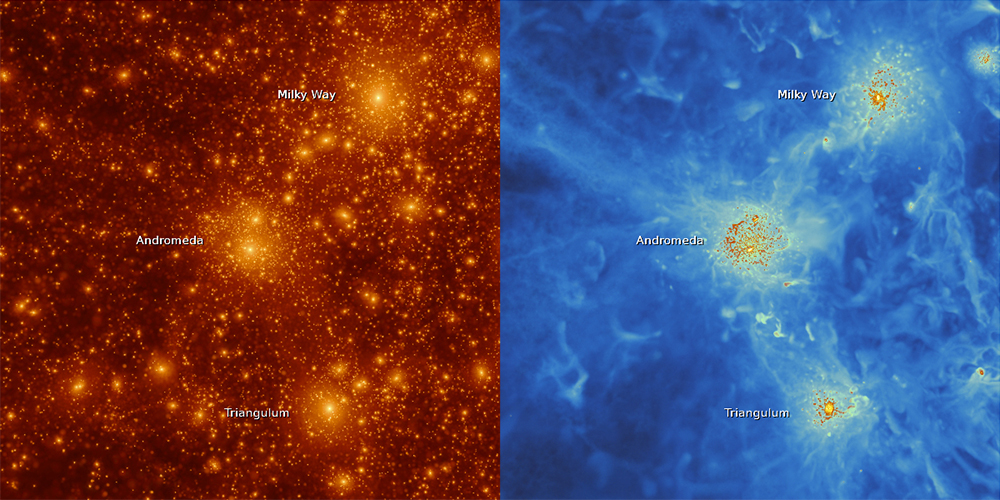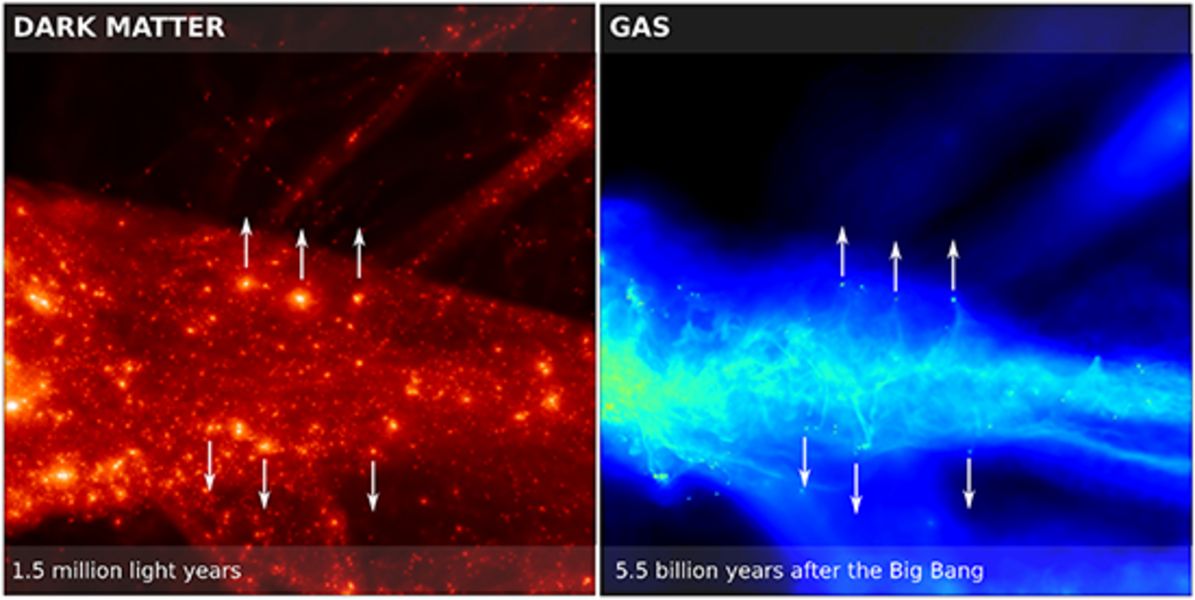ASTROPHYSICS
Local Supercluster Simulations
Principal Investigator:
Stefan Gottlöber
Affiliation:
Leibniz-Institut für Astrophysik Potsdam (Germany)
Local Project ID:
h009z
HPC Platform used:
SuperMUC of LRZ
Date published:
An international team of scientists performed a series of Constrained Simulations to study Near Field Cosmology. These high-resolution simulations allowed the astrophysicists, for the first time, to study the formation of the Local Group in the right cosmic environment.

Figure 1: Slice through a dark matter simulation. The size of the box is 587 million light years. A few well known nearby clusters are marked.
Copyright: CLUES teamNumerical simulations are the driving force behind much of the theoretical progress in our understanding of the formation of structure in the universe. Cosmological simulations must cover a large dynamical and mass range. A representative volume of the universe should be large, but this comes at the expense of the resolution. To overcome this problem a new approach has been developed over the last decade that consists of using the observed positions and radial velocities of galaxies in the nearby universe as constraints imposed on the initial conditions of a numerical simulation. The resulting (so-called) “constrained” simulation successfully reproduces the observed structure within a few tens and up to a couple of hundreds of Million light years around our galaxy, the Milky Way.
The Milky Way and Andromeda are the two most massive members of the Local Group which also contains a few dozens smaller dwarf galaxies. Within the Local Group and the surrounding Local Volume, even very small objects can be observed. Understanding how the small scale structure forms in the Universe is a major challenge to the standard model of structure formation. This model overpredicts the number of galactic satellites and dwarf galaxies compared to what is observed locally, in and around the Local Group of galaxies. This and other problems have prompted cosmologists to turn into ’archeologists’ looking for fossils and clues from the early formation phase in the present day structure of the Local Group, practicing so-called “near field cosmology”. Cosmologists have followed astronomers and extended near field cosmology to numerical cosmology. This is done by performing Constrained Local UniversE Simulations (CLUES), designed to reproduce the structure of the nearby universe. The initial conditions of the constrained simulation, (namely the distribution of matter shortly after the big bang some 13 Gigayears ago) are reconstructed based on observational data collected today. Then the clustering due to gravity is followed numerically until present day structures are reproduced in the supercomputer.
Our Milky Way is a spiral galaxy which, together with another spiral galaxy of approximately the same mass (the Andromeda galaxy), form the main members of the Local Group of galaxies. The third largest member of this group is a somewhat smaller spiral galaxy (called the Triangulum Galaxy). In total the Local Group comprises more than 50 galaxies that are distributed in a sphere of about 10 million light-years across centered between Andromeda and Milky Way. At a distance of around 50 million light years from the Milky Way sits a huge cluster of galaxies (the Virgo cluster) which comprises more than 1000 galaxies. The large-scale structure around the Local Group is shown in Figure 1. The Virgo cluster forms the heart of the Local Supercluster which is the most massive structure in the Local Universe. Our Milky Way sits in a tiny filament below the Virgo cluster.
According to the standard cosmological paradigm our Universe is made of unknown Dark Energy (70%), unknown Cold Dark Matter (25%) and mere 5% of well known baryons. Structures form due to gravitational instability. Since most of the matter is made of dark matter one can simulate, in first approximation, the formation of structure in a dark matter only universe as demonstrated in Figure 1. Galaxies will be born at the same place where massive halos of dark matter have been formed. However, to compare in detail the formed structures with observed galaxies one needs to follow the gas of baryons in which observed stars form.
Such simulations require high spatial and mass resolution and are therefore expensive. Therefore, simulations are run where a high resolution region of interest is “zoomed in” on while lower resolution is kept surrounding it on the outside in order to provide the right tidal field. Thus zoomed high-resolution gas-dynamical simulations allow for the study of the formation of the Local Group in the right large-scale environment. An example is shown in Figure 2 with the dark matter distribution in the left panel and the gas distribution in the right panel.

Figure 2: Dark matter (left) and gas (right) distribution in the simulated Local Group.
Copyright: CLUES teamHigh resolution gas-dynamical simulations of the local universe can be used as a laboratory for testing the models of structure formation and theories of galaxy formation in particular on small scales and for low mass objects. The observed scarcity of dwarf galaxies is one of the prime challenges to our understanding of galaxy formation. A new mechanism called "cosmic web stripping" has been identified in the CLUES simulation of the formation of the Local Group. Web stripping is the process of removing most of the gas from a dwarf galaxy far away from the Milky Way and Andromeda galaxies. This occurs when a dwarf galaxy moves with very high velocity with respect to the local web – the network of filaments and pancakes within which the Local Group is embedded. If they cross a pancake of low gas density, much of the gas of the dwarf can be stripped away. This can be nicely seen in the right panel of Figure 3. With a heavily reduced gas supply, star formation ceased some billion years ago and the dwarfs dimmed away so that they can hardly be observed today.

Figure 3: The clumps of dark matter (left) and gas (right) move with high velocity through the filament. The dark matter clumps are not affected while the gas is almost completely stripped. The effect of web-stripping can be also watched on a series of movies at the CLUES project
Copyright: CLUES teamThe importance of cosmic web stripping on isolated low mass halos has not been recognized before because it is a purely gas-dynamical effect that requires gas-dynamical simulations of a sufficient large volumes to able to resolve properly both the cosmic web and the internal halo properties. This demands numerical resources that are available on the SuperMUC computer.
Project members:
Stefan Gottlöber, Hélène Courtois, Yehuda Hoffman, Noam Libeskind, Gustavo Yepes, Mario Abadi, Alejandro Benítez-Llambay, Chris Brook, Arianna DeCintio, Alexander Knebe, Julio Navarro, Matthias Steinmetz
Original publications:
Benítez-Llambay A.; Navarro, J.~F.; Abadi, M.~G.; Gottlöber, S.; Yepes, G.; Hoffman, Y.; Steinmetz, M., The imprint of reionization on the star formation histories of dwarf galaxies, MNRAS 450 (2015) 4207
Libeskind, N.I.; Knebe, A.; Hoffman, Y; Gottlöber, S., The universal nature of subhalo accretion, MNRAS 443 (2014) 1274L
Brook, C.B.; Di Cintio, A; Knebe, A.; Gottlöber, S.; Hoffman, Y.; Yepes, G.; Garrison-Kimmel, S., The stellar-to-halo mass relation for Local Group galaxies, ApJ 784L (2014) 14
Yepes, G; Gottlöber, S.; Hoffman, Y., Dark matter in the Local Universe, NewAR 58 (2014),1
Benítez-Llambay, A., Navarro, J.F., Abadi, M.G., Gottlöber, S., Yepes, G., Hoffman, Y., Steinmetz, M., Dwarf-galaxies and the Cosmic Web, APJ 763 (2013), L41.
Libeskind, N.I.; Hoffman, Y.; Knebe, A.; Steinmetz, M.; Gottlöber, S.; Metuki, O.; Yepes, G., The cosmic web and the orientation of angular momenta, MNRAS 421 (2012) 137
Knebe, A.; Libeskind, N.I.; Doumler, T.; Yepes, G.; Gottlöber, S.; Hoffman, Y., Renegade subhaloes in the Local Group, MNRAS 417 (2011) 56
Project Website:
https://www.clues-project.org/
Scientific Contact:
Dr. Stefan Gottlöber
Leibniz-Institut für Astrophysik Potsdam (AIP)
An der Sternwarte 16, D-14482 Potsdam (Germany)
e-mail: sgottloeber [@] aip.de